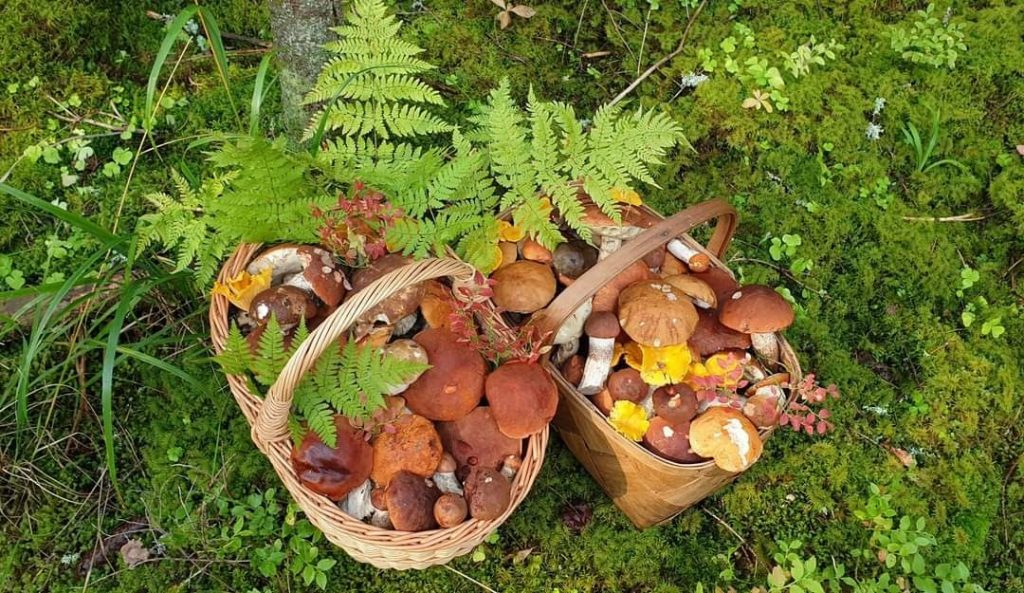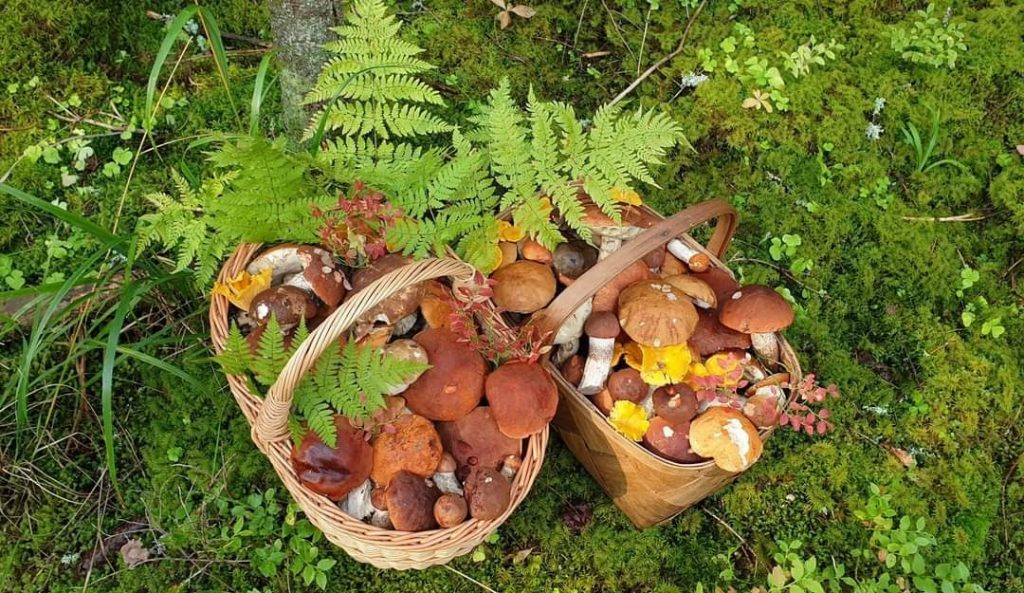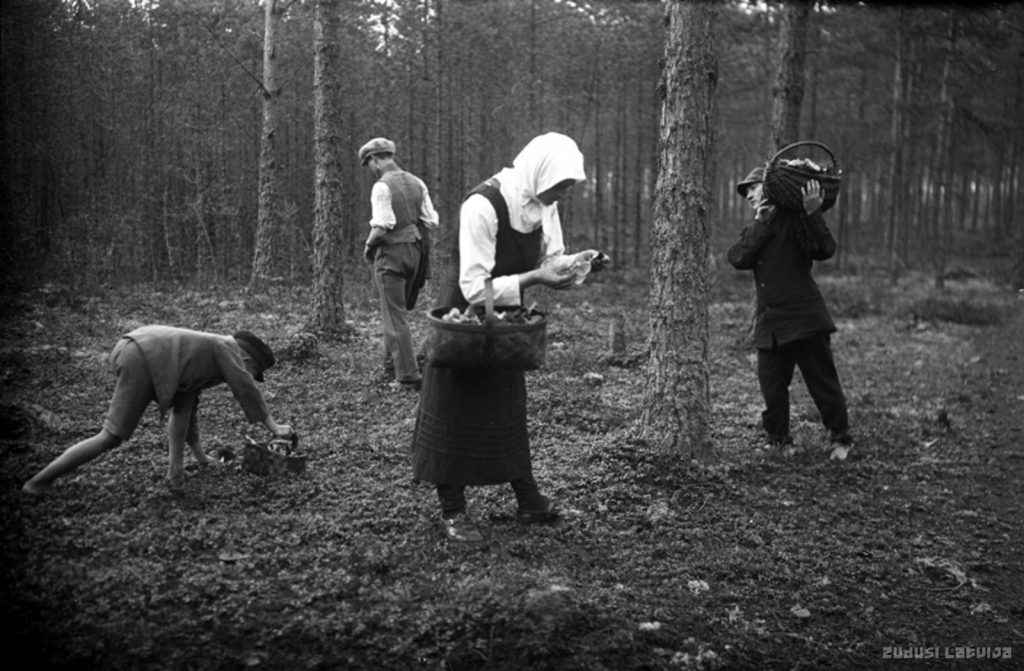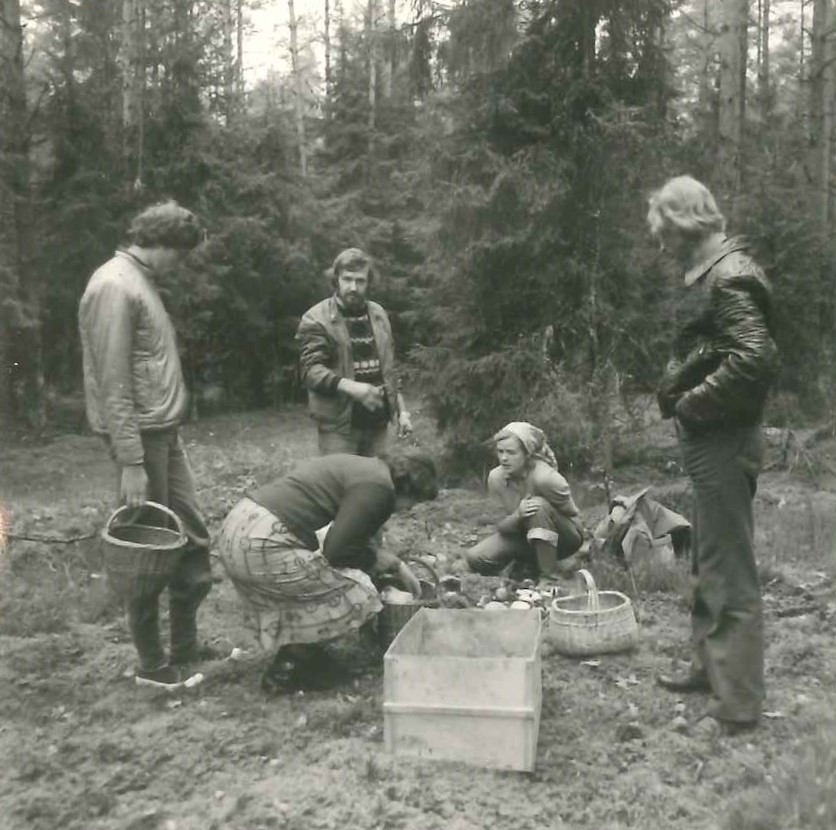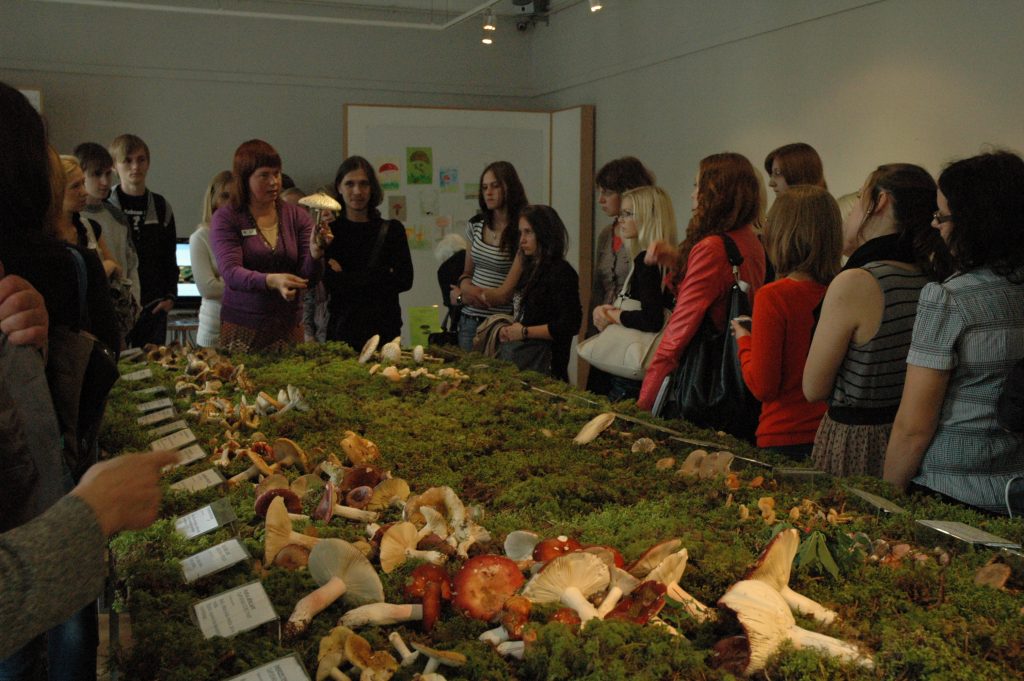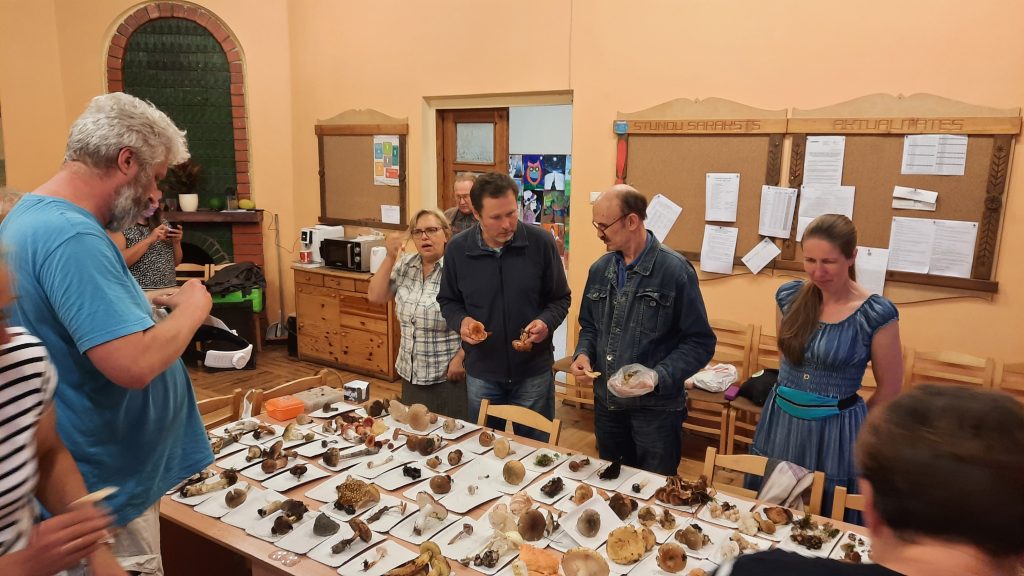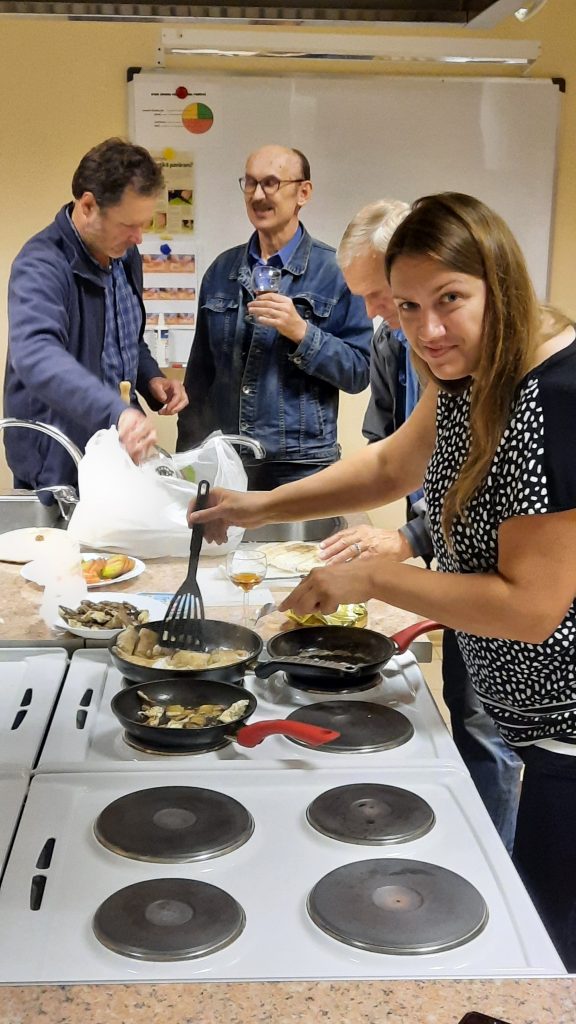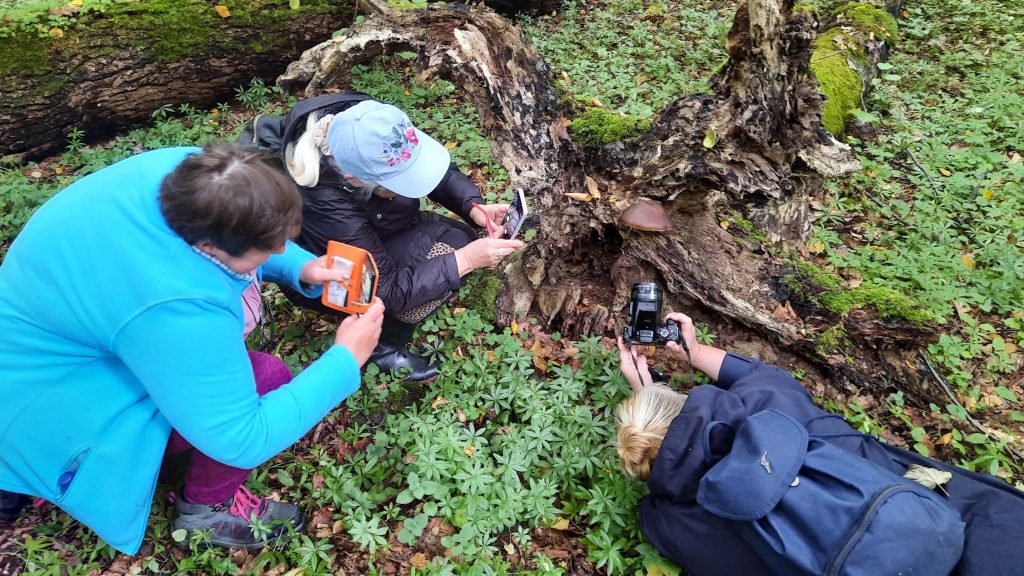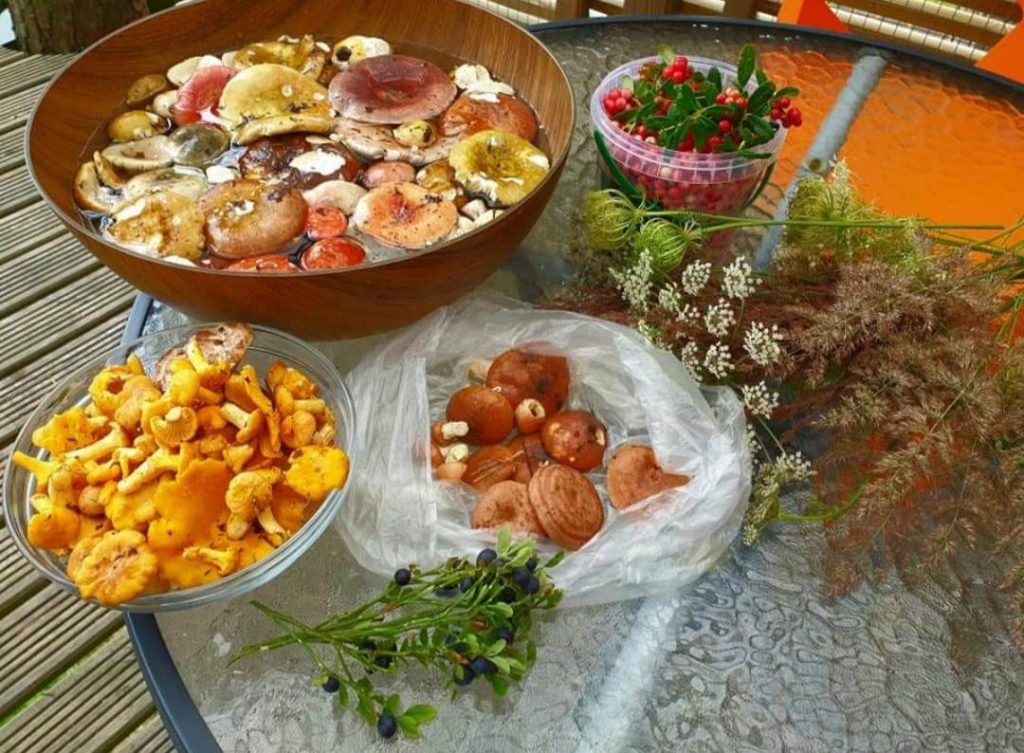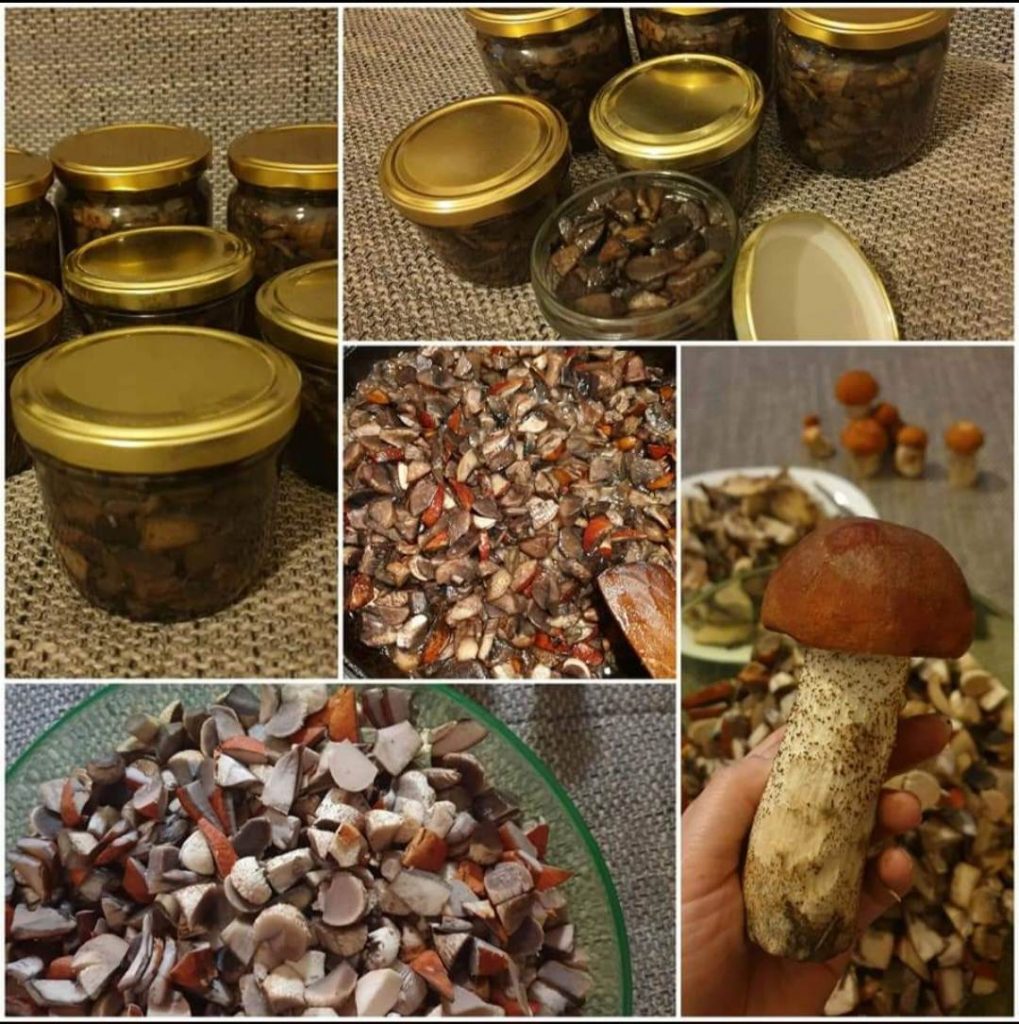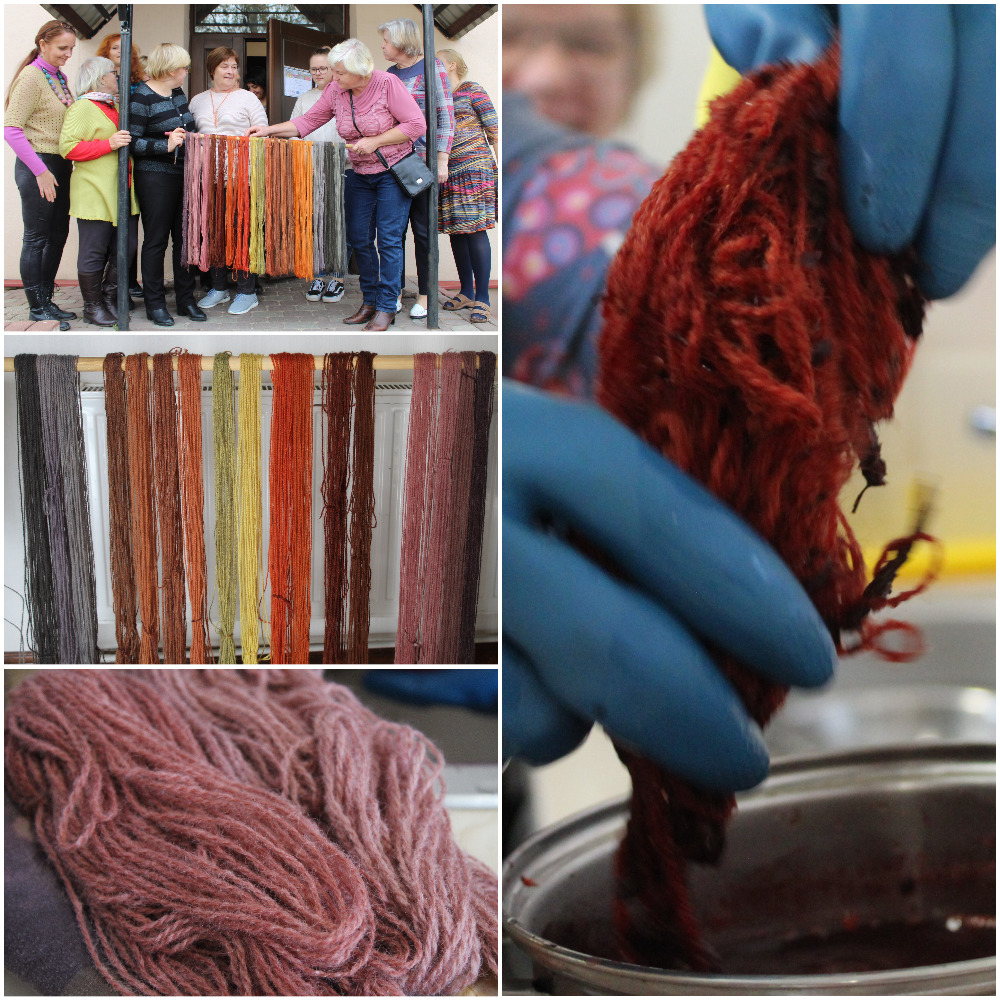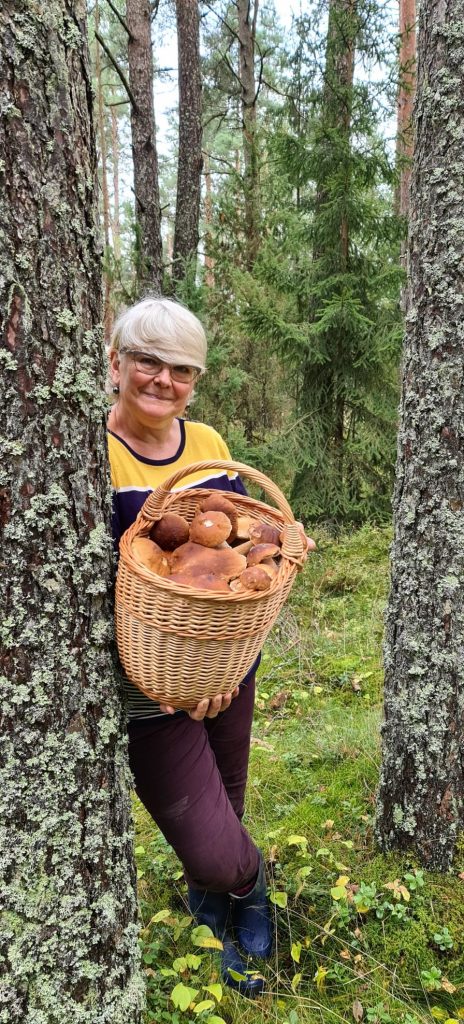Author:
Aiva Gailīte, Andra Simanova, Daiga Gargurne, Daiga Jamonte, Diāna Meiere, Evita Veinberga, Ineta Šumskiha, Ivo Treide, Lienīte Iesalniece, Maija Pohodņeva, Māra Kalve, Māra Treide, Zaiga Kaire
Traditional kitchen
Knowledge and practices concerning nature and the universe
Title
Mushroom Foraging and Usage (2023)
Mushroom Picking
Mushroom foraging traditionally involves collecting wild mushrooms, usually in forests, as well as processing and preparing the collected mushrooms for immediate consumption or storage as winter supplies.
Location
Throughout Latvia (including the diaspora outside Latvia).
The tradition of mushroom foraging is maintained and passed down through the families of mushroom pickers in Latvia. Through these families, the tradition is inherited from generation to generation – children, together with adults, learn to recognise, collect, and use mushrooms. This process not only transfers the skills of mushroom foraging but also associated knowledge, such as local mushroom names, beliefs and rituals, recipes, and their use in medicine, household tasks, and crafts.
Today, the mushroom foraging tradition is upheld by residents of both rural and urban areas in Latvia. Groups of like-minded individuals are playing an increasingly important role in preserving this tradition. The role of mushroom foraging in the community today is linked to acquiring new knowledge, reconnecting with nature, and promoting mental well-being. A mushroom-watching movement, similar to birdwatching, is also developing.
The most notable group of enthusiasts is the Latvian Mycological Society, founded in 2003. This organisation brings together scientists, mushroom foraging experts, and enthusiasts to promote the study of mushrooms. Over time, by collecting information on mushroom foraging and usage, the society has become a significant distributor of traditional knowledge, uniting 120 members. Of these, more than 40 actively participate in events organised by scientists (mycologists), as well as in activities and exhibitions related to mushroom foraging traditions. They organise educational events and hikes. During mushroom season, mushroom pickers from across Latvia seek advice from the most knowledgeable Latvian mycologists – Inita Dāniele and Diāna Meiere (both work at the Latvian National Museum of Nature and are active members of the Latvian Mycological Society) – to identify specific mushrooms they’ve found and determine whether they are edible. This ensures that even those whose families have lost the tradition of mushroom foraging, as well as the Latvian diaspora abroad, can acquire this knowledge. For the diaspora, preserving traditions characteristic of their ethnic community plays a significant role in maintaining national identity. This year, in collaboration with the Nature Museum, the Mycological Society is organising “Mushroom Days in Regions” for the first time. So far, six events have been held, led by the society’s most active and knowledgeable members and mushroom-foraging enthusiasts, including Līga Jēka (Ziras), Līvija Sproģe, Andris Maisiņš (Vaiņode), Inga Freimane, Sandra Miķelsone (Ranka, Jaungulbene), Andra Korņejeva (Žīguri), Zaiga Kaire (Dobele), Ivo and Māra Treides, and several others. The plan is to continue these efforts, as other experts in the society are ready to share their skills, helping mushroom pickers collect mushrooms safely.
A notable expert is Edgars Mūkins, who is not only an active mushroom picker himself but also runs senes.lv, Latvia's best mushroom website. There, he provides valuable information for mushroom pickers on how to use mushrooms for culinary purposes.
Importance in Community Life
The tradition of mushroom foraging has been known since ancient times, and its inheritance and transmission traditionally occurred within families. It plays a unifying role within communities – among Latvia’s multicultural society, mushroom foraging is a characteristic element of the lifestyle for people of various ethnicities. Often, each family or household has specific types of mushrooms they collect, unique mushroom-foraging spots, family recipes, inherited tools (such as the "mushroom knife"), and other customs. For many rural residents, mushroom gathering and selling remain an important source of income. Today, as the tradition evolves, the use of mushrooms is becoming increasingly wide.
Both historically and today, the primary use of mushrooms has been cooking and eating. In earlier times, they were a significant part of the diet. For example, mushrooms fried in pork fat were a typical dish for peasants in the 19th century. For winter, mushrooms were preserved by fermenting, salting, drying, or frying in fat or butter. Today, mushroom dishes – mushroom sauce, porcini schnitzel, pickled and salted mushrooms, among others – remain an essential part of Latvia's culinary heritage.
Mushrooms have also been used in households and medicine, for example, in infusions, tinctures, decoctions, and ointments. The best-known include common stinkhorn (still a popular ingredient in infusions), the fly agaric (used in ointments for rubbing), and chaga (used in medicinal teas). Fly agarics, mixed with sugar and milk, were traditionally used as a fly poison.
The collection of Latvian folk beliefs by Pēteris Šmits contains the following entries about the use of fly agarics:
21339. Fly agarics are placed in a bottle and heated in the oven. The resulting liquid is used to rub sore joints. /N. O. Grostona./
21340. Fly agarics are stuffed in a bottle, left to rot, and then covered with alchohol. This medicine is used for tingling in the hands and generally for rheumatism. /Etn. IV, 1894, Auļukalns./
21341. Fly agarics are soaked in alcohol and applied to areas that have bone pain. /P. Š. from P. Smelteris, Skaista./
21342. If someone has eaten fly agarics, they must lie in hemp for a while or they will go blind.
/K. B. Baldone. /
Fly agarics are smeared with cream, baked on a pan or sauteed on coals, flies then eat them and die. /P. Š. Etn. IV, 1894, Odziena./
Fly agarics must not be handled with bare hands; otherwise, the flies will not die. /A. A. Meirāni./
Boletes were used to lubricate door hinges, and hoof fungus were used to prepare fire starters.
There are also records of mushrooms being fed to livestock – slippery jacks, bovine boletes, and roll-rims were fed to cows, while mushroom broth was given to animals to drink.
Today, the tradition of mushroom foraging inspires artists and craftsmen in various fields. Examples include the play "Mushroom-Picking Championship" staged by Dirty Deal Teatro, I. Rubenis’s "Tales of the Old Boletes," M. Zālīte’s "Tango and Tūtiņa in the Mushrooms," and wooden mushroom sculptures in Tērvete Nature Park. Tourism specialists organise nature walks involving mushroom identification and gathering. Mushrooms are mentioned and depicted in Latvian literature and periodicals. Cartoonist Gatis Šļūka has created a series of cartoons on mushroom themes, reflecting both traditional customs (secret mushroom spots) and modern trends (studying and photographing mushrooms for social media alongside collecting them for consumption). In addition to popular children’s songs about mushrooms and mushroom picking, there are several pop music tracks referencing mushrooms, such as "The Mushroom Song" by F. Bārda, "Toksiskās sēnes" ("Toxic Mushrooms") by Katrīna Gupalo, and "Problēmas" ("Problems") by the band Pirmais Kurss.
From an early age, children have been taught the concept of good and bad using easily recognisable poisonous (fly agaric) and edible (porcini, chanterelle) mushrooms. Mushrooms continue to be used as symbols in kindergartens (to mark lockers) and children’s books. Many generations have grown up with books illustrated by Margarita Stāraste. For Latvian children, a mushroom is first a familiar and understandable fairy tale character and only later a food item, as well as a source of enjoyment during walks in the forest.
Activities
Mushroom foraging begins with preparation – choosing the appropriate clothing and equipment. A mushroom picker typically has a dedicated container for gathering, such as a basket or bucket, and a special "mushroom knife," often used exclusively for this purpose. Nowadays, if the mushroom haul is larger, even cardboard boxes in the car are deemed to be good enough, and occasionally various plastic bags. In cases of unexpectedly abundant harvests, even clothing might be repurposed to handle the situation. Special attire is also worn in the forest (a head covering, long-sleeved clothing to ward off mosquitoes, horseflies, and ticks) along with suitable footwear, most often rubber boots, to protect against stepping into damp areas or unwanted encounters with forest creatures, especially snakes.
Sometimes, rituals are performed before mushroom picking to ensure a good harvest, such as reciting certain words, holding the knife behind one’s back, spitting on the first mushroom, or leaving the prettiest mushroom in the forest etc.
Mushroom foraging takes place in forests, also parks, bush thickets, field edges, and pastures – in Latvia’s characteristic natural and cultural landscape – from the spring months onward. However, the best “mushroom season” is in late summer and autumn. During this period, pickers gather mushrooms, often visiting their favourite spots. Mushroom foraging usually occurs alone or in small groups, more often family groups (there is a belief that one should not reveal one’s mushroom-picking locations to others). One of the contentious issues among mushroom pickers, debated for over a century in Latvian press, is whether mushrooms should be cut with a knife or twisted out of the ground. Similarly, there is disagreement about whether mushrooms with "worms" (larvae) should be collected.
Depending on the region, family traditions, or knowledge acquired elsewhere, a greater or smaller variety of mushroom species is gathered. Most mushroom pickers consider the porcini mushroom the most valuable, but chanterelles, aspen boletes, birch boletes, russulas, and milk caps are also popular.
Traditionally, mushrooms are most often used as food, less frequently in folk medicine (stinkhorn and chaga are notable examples) and other applications. Mushrooms are made into sauces and soups, fried (in a pan or over coals), dried, salted, fermented, pickled, and in recent decades, frozen.
A 1925 issue of Zemkopis describes mushroom foraging as follows: “Grandmothers would take the children mushroom picking daily unless something urgent needed attention. Shepherd girls whose pastures bordered the forest always carried a basket and almost single-handedly provided mushrooms for immediate use. But when rainy days came and fieldwork was impossible, everyone went mushroom picking, including the head of the household himself. Everyone dressed in older clothes so they could remove the wet clothes after returning and change into dry ones. Mushrooms were not uprooted but cut, and worm-eaten ones were left behind. Only familiar mushrooms were gathered: chanterelles, boletes, porcinis, russulas, honey mushrooms, hedgehog mushrooms, alder milk caps, woolly milk caps, salted milk caps, saffron milk caps, rough milk caps, and red-cracked boletes. This way, there was no fear of poisonous or inedible mushrooms. Everyone was familiar with mushrooms, even the children. After returning home, the mushrooms were collectively sorted, with overly soft boletes, worm-eaten ones, and unfamiliar species set aside. Women then cleaned and washed the mushrooms. Only after this did the housewife take charge, separating sweet from bitter ones. The latter were placed in cold water and boiled, then drained and left in a small tub of cold water until the next day. Afterward, broken or unattractive mushrooms were collected into a strong cloth bag and pressed between two boards weighted with heavy stones. Soft mushrooms, boletes, and porcinis were not boiled but simply rinsed with hot water. Later, all the mushrooms were combined. A delicious treat for everyone was fried mushrooms, especially pressed porcinis and young boletes, coated in beaten eggs and fine flour with salt and pepper, like fresh fish.
Mushrooms set aside for winter were left under weights for a couple of days, then packed into a bucket or small tub in layers, sprinkled with salt, covered with a clean cloth, and weighted with a stone-topped lid. Each subsequent batch was added to the first until the container was full. Throughout the autumn, the mushrooms were kept outdoors under an apple tree and only brought inside when frosts began.
Mushrooms were most often boiled with finely chopped fatty pork and onions, served with milk or cream, and enjoyed with potatoes. Leftover pork fat scraps (‘ķikuri’ or ‘cībaras’) were sometimes used instead of meat. Mushrooms were also fried with fat and a bit of butter. Occasionally, salted mushrooms were made into salads: soaked in warm water for several hours, squeezed dry, chopped into small pieces, and marinated in a mixture of vinegar, onions and spices, then boiled together and cooled. If there was an abundance of porcinis one year, they were prepared this way. The firm rollrim milkcaps were also delicious when prepared this way.
By following such practices, every household near mushroom-rich forests could ensure mushrooms for winter use, providing delicious meals not only in summer and autumn, but also in winter.” (Zemkopis, No. 35, 02.09.1925, periodika.lv)
(Zemkopis, Nr.35 (02.09.1925), periodika.lv)
Beliefs, Rituals, Unwritten Rules
A wealth of beliefs and folklore related to mushroom foraging has been recorded. Below are examples from Pēteris Šmits' compiled collection Latvian Folk Beliefs.
Beliefs about mushroom growth:
26721. Boletes do not grow until rye has finished blooming. /K. Jansons, Plāņi./
26722. Mushrooms and boletes grow in a single night, but once a person has seen them, they will not grow any larger. /P. Š., Rauna./
26723. If mushrooms sprout during the waning moon, they become wormy; if during the waxing moon, they remain clean. /J. Auziņš, Sērene./
26724.During the waning moon, mushrooms are wormy; during the waxing moon, they are clean. /M. Auziņa, Rīga./
Beliefs about luck in mushroom foraging:
26725. If a person going to the forest for mushrooms meets a woman with a basket full of mushrooms, they will also find mushrooms. But if her basket is empty, theirs will be empty too, no matter how long they search. /V. Podis, Rēzekne./
26726. When going mushroom picking, place the knife behind your back, and you’ll see all the mushrooms. /A. Dragone, Palsmane./
26727. When entering the forest to pick mushrooms, say: “Čiku, čiku, meža Miku, pilna āda baraviku!” (Chiku, chiku, forest Mikus, a full basket of boletes!) and you’ll find plenty of mushrooms. /L. Kleinberga, Svēte./
26728. When mushroom picking, spit on the first mushroom you find and say: “May you be the lucky one, quickly fill my basket!” This will help fill the basket quickly. /A. Aizsils, Lubāna./
26729. When placing the first mushroom or berry in the basket, say: “God, grant me luck!” to fill the basket quickly. /K. Lielozols, Nīca./
26730. If you find your first mushroom as an old, wormy bolete, it’s a sign your life will be troubled, like the worms eating away at you. But if the first is fresh and worm-free, it’s a sign of a good and happy life. /V. Podis, Rēzekne./
26731. If the first mushroom placed in the basket is a bolete, the basket will fill; if it’s a russula, it will only fill halfway. /A. Salmāns, Balvi./
26732. Finding a chanterelle first when mushroom picking brings good luck. /K. Lielozols, Nīca./
26733. Finding a russula first when mushroom picking brings bad luck. /K. Lielozols, Nīca./
26734. When mushroom foraging with others, never give your mushrooms to someone else, as you’ll also give away your luck. /P. Zeltiņa, Sigulda./
26735. Mushroom pickers often throw away the most beautiful mushroom at the edge of the forest when leaving, to ensure good luck on their next outing. /K. Corbiks, Valgunde./
Beliefs about predicting weather or harvest volume
26736. If there are many mushrooms one summer, it will be a poor year. /K. Pavasare, Mujāni. P. Š., Rauna./
26737. A large number of mushrooms signifies war. /V. Pilipjonoks, Asūne./
26738. When there are many mushrooms and boletes, famine years are expected. /K. Jansons, Plāņi./
26739. If there are many mushrooms one summer, famine will follow in winter. /A. Aizsils, Lubāna./
26740. A year with many mushrooms will bring famine. /K. Corbiks, Valgunde./
26741. If there are many mushrooms one summer, famine will follow in winter. /A. Aizsils, Lubāna./
26742. A forest abundant with various mushrooms predicts hard times, and those who gather such mushrooms with bare hands will age quickly. /V. Podis, Rēzekne./
26743. If there are many mushrooms in the forest late in autumn, the next year’s barley harvest will be poor. /J. A. Jansons, Rāmuļi./
26744. Many mushrooms in autumn predict a bad grain harvest the following year. /H. Laimiņš, Druviena./
26745. If the forest is full of mushrooms in autumn, next year’s grain harvest will be poor. /P. Š., Druviena./
26746. If there are lots of mushrooms, there will be little bread next year./K. Rasa, Kalnamuiža./
26747. If mushrooms do not grow in a given year, the harvest will be bountiful. /P. Zeltiņa, Rīga./
(If there lots of mushrooms, there will be little bread next year.).
Beliefs about mushrooms in dreams
26748. If you dream of picking mushrooms, you will have to attend a funeral. /P. Š., Rauna. J. Jurjāns, Jaungulbene./
26749. Seeing mushrooms being picked in a dream foretells the death of a family member. /A. Oše, Lubāna./
26750. Dreaming of gathering mushrooms signifies someone’s death. /L. Ozole, Rīga./
26751. Dreaming of picking mushrooms means a relative will die. /A. Jaunzeme, Lizums./
26752. Seeing mushrooms in a dream is a sign of death. /J. Kalniņš, Druviena./
26753. Dreaming of collecting boletes means death is near or the weather will change. /M. Stupele, Rīga./
26754. Seeing mushrooms in a dream foretells dealing with the dead. /L. Saliņa, Lubāna./
In modern times, one of the most common practices is to keep one’s mushroom spots secret from “outsiders.” There are also various methods for determining whether a mushroom is poisonous or of good quality. For instance, a mushroom with a ring, a bulb, or a bitter taste is considered poisonous. Additionally, if an onion added to boiling mushrooms changes colour, or a silver spoon blackens, the mushroom is deemed unsafe to eat.
Inheritance and Transfer
In the past, mushroom gathering for food was a practice in every family, passed down from generation to generation. Even today, some families continue this tradition, with children joining their parents or grandparents in mushroom foraging from an early age and later passing on the knowledge themselves.
With the urbanisation and globalisation of society's lifestyle, mushroom foraging has become a significant hobby. The methods of knowledge transmission have changed, often shifting to peer learning, interest groups (such as the Facebook groups “Mikologu biedrība un draugi” [Mycologists’ Association and Friends], “Sēņu medniekiem” [For Mushroom Hunters], and “Latvijas sēņotāji” [Latvian Mushroom Pickers], and materials published in print or available online. These resources are particularly important for maintaining the tradition among the Latvian diaspora abroad. However, it is increasingly common to encounter young people who have not gone mushroom picking with their parents or grandparents. Efforts should be made to find ways to spark their interest and involve them in this activity.
History
In the territory of Latvia, mushroom gathering may have been known as early as the late Palaeolithic period, around the 13th–10th millennia BCE, when Finno-Ugric hunter-gatherer tribes arrived after the retreat of the ice sheet. Although there is a lack of research on mushroom use in Latvia, scholars suggest that mushrooms were already part of the inhabitants' diet during this period.
The word sēne (mushroom) is borrowed from Finno-Ugric languages (Livonian, Estonian).
Evidence of mushroom foraging and consumption has been preserved in folklore materials, including folk songs, beliefs, riddles, and proverbs.
The first mentions of mushrooms in published Latvian sources appear in the 17th century. Researchers note that the word sēne was included in the first Latvian dictionaries – Mancelis’ Lettus (1638) and Langius’ dictionary (1685).
Mushrooms were also mentioned in the German press published in Latvia, such as the newspaper Rigische Anzeigen (No. 52, 27 December 1764), which included guidance on identifying edible mushrooms to avoid confusion with poisonous ones. Chanterelles were among those highlighted. In 1795, the first Latvian cookbook by K. Harder, "Tā pirmā pavāru grāmata" (The First Cookbook), included several mushroom recipes. Mushrooms were among the forest goods that peasants were required to deliver as dues to manors, as noted by Garlieb Merkel in "Latvieši" (The Latvians, 1796).
The 19th century saw the beginning of research into mushroom gathering traditions. Pharmacist Ernests Birzmanis documented over 30 mushroom species, their folk names, and uses for the 1896 Latvian Ethnographic Exhibition.
In the early 20th century, professional naturalists played a key role in educating the public. Riga hosted the first mushroom exhibition in 1918, and in 1934 the first mycology book in Latvian, Ferdinands Erdmanis Štolls’ Latvijas sēnes (Mushrooms of Latvia), was published. Its aim was to provide extensive information on edible and poisonous mushrooms in Latvia. The organisation of mushroom exhibitions transitioned from the Riga Dome Museum to the School Museum, and after the war (since 1952), to the Latvian Museum of Natural History. In the 1950s and 60s, mushroom exhibitions were particularly popular in schools, as evidenced by numerous reports on the website periodika.lv. Specialists from the Museum of Natural History actively assisted in organising exhibitions and lectures for people in various regions. While regional exhibitions gradually declined, the museum continues this tradition to this day. Thanks to the activities of the Mycologists' Association, the organisation of regular regional mushroom days may resume. The publication of The Great Latvian Mushroom Book in 2020 significantly boosted interest in mushrooms. This book highlights the rich diversity of mushrooms in Latvia and helps gatherers confirm existing knowledge and acquire new insights into using mushrooms for food.
Traditionally, mushroom foraging has served as a supplementary source of food and income. Today, its role in food provision has diminished, and the tradition has become an important element of national identity, a way to connect with nature, and a source of intellectual satisfaction.
Nowadays, the concept of sēņošana (mushroom foraging) has broadened, reflecting the diverse uses of mushrooms – not only as food and in folk medicine but also for dyeing yarn and other materials. Industrial uses of mushrooms are also gaining popularity, spurring general interest in them. Maintaining the tradition relies on educational activities, museum exhibitions, school and preschool programmes, mushroom foraging camps, and hikes.
Modern mushroom gatherers consider mobile phones indispensable, using them to track their location on maps, take photos, and compare mushrooms with images in species recognition apps. While the methods of passing on traditions have changed, the core desire remains the same: to be in the forest, to search, collect, and prepare these valuable gifts of the forest.
Additional Information
Mushrooms and mushroom gathering are closely linked to Latvian oral traditions.
Firstly, this connection is evident in the diverse regional names for mushrooms. These names have been documented in older publications about mushrooms, though their use has begun to decline in modern times due to the increasing reliance on books and online resources that use standardized terminology. However, there have never been many widely used folk names for mushrooms. Associate Professor A. Zāmelis notes, “Approximately 33 mushrooms have known Latvian names. The Dainas (folk songs) mention the following mushrooms: "baravika" (boletus edulis), "peka" or "beka" (boletus species, also used generically for mushrooms), "vilniņi" (lactarius torminosus), "krimildas" (lactarius piperatus), rozenes (a species of lactarius), "rudmieses" (lactarius deliciosus), "bērzlapīte" (russula species), "mušmiŗes" (amanita muscaria), gailenes (cantharellus cibarius), "pūpēdis" (bovista globaria and lycoperdon species), "bisītes" or "lāčpurni" (helvella esculenta), and "vērpelīte" (? morchella esculenta, morels).”
In the Dainas, mushroom gatherers are encouraged to rise early so that “the squirrel doesn’t pick the mushrooms first” and are reminded to give thanks for a good mushroom harvest.
Paldies Dievu Dieviņam, [Thank dear God]
Šogad bekas devušās: [This year the boletes have grown:]
Es iegāju siliņa, [I entered the pine grove,]
Pielauz` pilni vācelīti. [And filled my basket to the brim.]
Ogu, ogu, sēņu, sēņu [Berries, berries, mushrooms, mushrooms]
Bāleliņu laukmalê [By the forest edge of young men]
Kad àzgāju tautiņâs,[But when I married into one's home]
Ne tur ogu, ne tur sēņu. [There were neither berries nor mushrooms.]
However, mushroom gathering practices may have differed from those of today. For instance, it seems that boletes were not considered the most prized find:
Visi lauza labas sēnes, [Everyone picks the good mushrooms]
Kas tàs lauza, baravikas? [Who would pick the boletes?]
Visi ņēma skaistas meitas, [Everyone chooses fair maidens,]
Kas ņems mani neskaisto? [Who will take me, the plain one?]
A similar attitude towards mushrooms and mushroom foraging is reflected in other Dainas:
Tādi vien sanākuši [What kind have gathered here,]
Sila beku lauzejiņi; [These pine grove bolete pickers?]
Nav neviena gudra vīra, [Not a single wise man among them,]
Kas ar mani parunà. [To share a word with me.]
Bij māsiņa steigusies, [The sister was in a rush,]
Nu vīriņu dabujusi: [Now she got a husband:]
Sēņu, beku lauzejiņu, [A picker of mushrooms and boletes]
Ne maizites devejiņu. [Not a giver of bread.]
Dievs nedod tādas meitas, [God forbid daughters like these,]
Kādas meitas saimniekam: [The kind the master has:]
Uz galdiem sēnes auga, {Mushrooms grew on tables,]
Uz beņķiem baraviki. [On the benches, boletes.]
In Latvian, comparisons involving mushrooms are often used with a derogatory connotation. For example, older people might be referred to as a “veca beka” ("old bolete") or “vecais pūpēdis” ("old puffball"), comparing human traits to those of a spoiled mushroom. Alternatively, the more neutral phrase “tup kā beka” ("sits like a mushroom") describes someone sitting still, as mushrooms do not move. In a more modern context, slow drivers are sometimes called “sēņotāji” ("mushroom pickers"), as mushroom pickers also move slowly when searching. Similarly, phrases like “ko tu sēņo” ("why are you picking mushrooms") or “nu, nesēņojam jau” ("come on, we’re not picking mushrooms") might be used to urge someone to hurry up.
Riddles about mushrooms often focus on their appearance:
"Small, small men, standing in a row, with broad hats on their heads." Answer: Mushrooms.
(https://garamantas.lv/lv/file/897611/0584-Valmiera-elementary School-vacancy-01-0043) 366
Ridged on top, grooved underneath." Answer: A mushroom.
(https://garamantas.lv/lv/file/1094621/0855-peteris-Birkert-08-0010) 3624
"Men at the edge of the forest all have nice little hats." Answer: Mushrooms.
(https://garamantas.lv/lv/file/1095240/0855-peteris-Birkert-14-0055) 15952
"Little pots standing on one leg." Answer: Mushrooms.(https://garamantas.lv/lv/file/468754/1729-Tuja-elementary school-0115) 931
"What are those leaves that aren’t leaves, don’t grow on trees, but people love to eat?" Answer: Mushrooms.(https://garamantas.lv/lv/file/1095305/0855-peteris-Birkert-15-0029) 17833
Masters
In families and communities, there are still enthusiasts of mushroom foraging and hosts who have preserved their culinary heritage and continue to adapt it to modern requirements.
Traditional mushroom dishes such as porcini soup and chanterelle sauce are served in nearly all restaurants and guesthouses. Some guesthouses offer a much wider range of mushroom dishes, including soups, pickles, and fried mushrooms, introducing visitors to the culinary possibilities of mushrooms. One such example is the guesthouse Mauriņi, where the hostess Māra Zemdega (a former participant in the show Īstās latvju saimnieces) delights guests with a variety of mushroom-based dishes, often including mushrooms in every course of the meal except dessert.
Several well-known Latvian chefs frequently incorporate mushrooms into their dishes as a reflection of local traditions. For instance, Mārtiņš Rītiņš prepared not only dishes featuring exotic truffles but also those using parasol mushrooms, morels, chanterelles, and other forest mushrooms. One episode of chef Renārs Purmalis’s show Gatavo dabā was dedicated entirely to mushroom cooking. Similarly, the renowned chef Ēriks Dreibants, while advocating the use of Latvia’s abundant natural resources, highlights seasonal mushrooms in the menu at his restaurant Pavāru Māja Līgatnē. Seasonal menus there include a variety of mushroom dishes such as “Organic venison stew with forest mushrooms and parsnip purée,” “Forest mushroom broth, venison, and organic shiitake mushrooms,” “24-hour braised ox cheek with oyster mushroom salad and porcini glaze,” “Cured venison with pickled chanterelles and lightly salted cucumber” (autumn menu), “Chanterelle soufflé with new potatoes and black truffle croquette” (summer menu), “Juniper-smoked venison chop with Brussels sprouts and black trumpet mushrooms” (winter menu), salted venison with marinated chanterelles and truffle mayo", "Duck with carrot souffle and chanterelle glaze" and others.
The writer Maija Pohodņeva has focused on compiling research about the medicinal properties of mushrooms, authoring the book "Aliansē pret vēzi" (Alliance Against Cancer) (Maija Pohodņeva, Modris Pelsis)
The preservation of mushroom foraging traditions relies significantly on both active practitioners and academic researchers, particularly mycologists.
Since the second half of the 20th century, the most notable mycologist has been Associate Professor Edgars Vimba, under whose guidance many of Latvia’s current mycologists learned to identify mushrooms.
Mycologists Inita Dāniele and Diāna Meiere, authors of Lielā sēņu grāmata (The Great Mushroom Book), provide regular consultations about mushrooms in person, on social media, and via email, both professionally and personally. Their book serves as a valuable resource for mushroom enthusiasts who have not inherited foraging skills from their families and for those seeking to rekindle lost knowledge or acquire new insights about mushroom species.
The enthusiasts of the Latvian Mycological Society, who over time have gathered and compiled information about the tradition of mushroom foraging and its associated intangible cultural heritage, serve as an important source of knowledge for various like-minded groups. The members have organised various events dedicated to mushroom identification and promoting mushrooms. In 2023, marking the 20th anniversary of the Latvian Mycological Society, the "Mushroom Days in the Regions" were held, with events taking place in Zirā, Vaiņode, Ranka, Sigulda, Pokaiņi, Jaunpiebalga, and Žīģuri. The organisers of these mushroom exhibitions and other activities include mushroom and foraging enthusiasts such as Līga Jēka, Līvija Sproģe, Ivo and Māra Treides, Ilze Viļumsone, Evita Veinberga, Agnis Graudulis, Inga Freimane, Sandra Miķelsone, Zaiga Kaire, Audra Levickiote, Edgars Mūkins, and others.
Agencies and Institutions
The Latvian Mycological Society was founded in 2003, and its objectives are related to the study of mushrooms in Latvia, as well as the promotion and dissemination of knowledge about mushrooms in society, including the planning and implementation of various events.
The Latvian National Museum of Natural History is involved in the study of Latvia's nature, including mushrooms, and in public education. The museum employs leading Latvian mycologists who authored the "Great Book of Latvian Mushrooms," published in 2020. The museum organises annual mushroom exhibitions and promotes mushrooms and foraging at other events as well.
The Nature Conservation Agency regularly organises nature exploration events and hikes, including Mushroom Days in protected areas (in Slītere, Rāzna and Ķemeri National Parks, Līgatne Nature Trails, and elsewhere). At these events, the mycologists Inita Dāniele and Diāna Meiere, along with the most active members of the Mycological Society, such as Edgars Mūkins, Ēriks Začs, and others, predominantly share their knowledge.
Strengthening
The largest mushroom-related event is the annual mushroom exhibition held at the Latvian National Museum of Natural History. Mushroom exhibitions and hikes are also regularly organised in protected natural areas (by the Nature Conservation Agency (NCA) in cooperation with the Latvian Mycological Society), in regional museums, and by local authorities.
Mushrooms and mushroom foraging are promoted in both print and digital media, and mycologists are interviewed on the radio and television during the mushroom season. Several specialised publications on foraging and mushrooms have been released, and in 2020, the "Great Book of Latvian Mushrooms" was published, becoming the best-selling book of the year.
The Latvian Mycological Society organises various educational series ("Mycology in 60 minutes" via Zoom; the "Mushroom School" lecture series, and others), as well as spring hikes and summer camps in different regions for its members. In 2022, the society released the Mushroom Observer’s Calendar, which will help identify mushrooms (including edible and poisonous varieties) even after the year ends. The Latvian Mycological Society nominates the Mushroom of the Year annually; the announcement is published in the media, encouraging public engagement and knowledge acquisition, as well as providing additional information about the distribution of a specific species.
Other organisations also arrange mushroom-related excursions, hikes, workshops, and other public and private events dedicated to mushroom identification, collection, processing, usage, cultivation, etc.
On social media, there are several interest groups that unite both foragers, specialists, and enthusiasts, expanding each individual's knowledge base (for example, "Latvian Mycological Society and Friends," "For Mushroom Hunters," and others).
In various regions of Latvia, Mushroom Foraging Championships are held, such as in Tome, Ogre municipality, where they have been organised for 17 years. In other places, night mushroom foraging championships are also held. In the Gulbene district, there are mushroom picking competitions called “Nosēņo Kokaru” ["Out-forage Kokars,"] which include categories for mushroom picking (quantity, diversity, weight) and photography.
Interest in foraging traditions continues to grow, along with the overall education of the public. As more people learn about the mushroom world, many discover new edible mushroom species; the number of observations and species on the Dabasdati.lv nature observation portal has increased. The growing public interest in mushrooms is well reflected by the increasing number of participants in thematic social media groups (currently, more than 60,000 members) and in the activities of these groups. The increasing volume of media reports about mushrooms also highlights the growing public awareness of the diversity of collectable species and their use. Various interest groups also promote the study of rare species and contribute to the discovery of new species. Interest in mushrooms has also found its way into art, manifesting in modern art installations, ceramics, and other artistic fields. In 2020, the multimedia project "Nature Concert Hall" was dedicated to mushrooms.
The Latvian National Museum of Natural History organises regular events (mushroom exhibitions, family days, school activities).
The Nature Conservation Agency's regional administrations, in collaboration with mycologists from the Latvian Mycological Society, organise mushroom identification hikes in protected areas (inviting mycologists from the Latvian National Museum of Natural History and the Latvian Mycological Society).
The Latvian National Museum of Natural History, in cooperation with the Latvian Mycological Society, also organised a remote lecture series for interested parties in 2020, called "Mushroom School."
Local authorities, museums, and libraries have also organised small exhibitions or informative lectures about mushrooms in various regions.
In 2023, the Latvian Mycological Society organised "Mushroom Days" in different regions, during which the society’s specialists held several exhibitions in various Latvian villages.
Mushroom picking championships are organised in some regions at the initiative of local authorities.
In the future, the Latvian National Museum of Natural History will continue to operate under the museum’s competence, continuing the events it organises.
The Latvian Mycological Society supported the organisation of the 2023 Mushroom Days with its own resources, but for a wider scale, these resources are not enough. Therefore, there are plans to attract additional funding for specific projects.
Continuity/Development
The Latvian Mycological Society has developed an action plan for the research and documentation of Latvia's mushroom foraging tradition, which is intended to be implemented with the participation of the society’s members and cooperating organisations (such as the Latvian National Museum of Natural History, the Nature Conservation Agency, the Latvian Nature Tourism Association, and others), with additional funding to be attracted for the implementation of the plan:
The collection of archival materials – folklore, periodicals, and traditional ecological knowledge – has already begun and will continue in the future. This is an essential source for both maintaining the tradition and for research purposes.
Gathering information about the mushroom foraging tradition from social media interest groups, organised mushroom identification events, exhibitions, and hikes, which includes both research materials (species identification) and documentation (video and photographic materials).
Surveys of people of different ages about the mushroom foraging tradition, summarising the survey results, and using them to prepare publications.
Ethno-mycological expeditions/hikes, documenting and applying modern ecological knowledge about mushrooms, their collection, and preparation in research;
To promote the recognition of mushroom foraging, the following actions are planned:
1. Exhibitions on the mushroom foraging tradition and mushrooms at the Latvian National Museum of Natural History, in collaboration with other museums (2026–2027).
2. The creation of a collection of popular science publications, revealing various historical and modern aspects of the mushroom foraging tradition – the use of mushrooms in folk medicine, household practices, related beliefs and customs, mushroom preparation techniques, traditional mushroom-related crafts (such as basket weaving), and interviews with experts on the tradition.
3. Publishing a book on dyeing yarn with mushroom pigments (manuscript author – mycologist Diāna Meiere).
Incorporating the mushroom foraging tradition into the list of Intangible Cultural Heritage elements is a significant step in the preservation and sustainable development of the tradition.
The society's activities will place particular emphasis on supplementing, revitalising, and transmitting traditional knowledge, promoting the sustainability of the tradition and the careful use of mushroom resources:
Autumn mushroom exhibitions at the Latvian National Museum of Natural History and in regions, organising mushroom exhibitions in various Latvian districts and involving more community members in their preparation and organisation, with the aim of generating greater interest in the tradition. The function of these exhibitions is not only to demonstrate mushroom species and their uses but also to unite community members, encouraging the maintenance, restoration, and creation of family traditions.
Organising mushroom festivals and other events to promote mushroom foraging, understanding the ecological role of mushrooms, and demonstrating how mushrooms can be used in our everyday life to a broader audience.
4. Developing educational materials on mushrooms and mushroom foraging. Preparing and conducting a lecture series in various Latvian regions. Continuing seminars and training cycles (including the “School Backpack” program, creative workshops for learning about lost mushroom uses, and their creative applications), and organising outdoor activities.
5. Collaboration with the Nature Tourism Association to promote mushroom foraging traditions beyond Latvia.
6. Raising funding for educating and rewarding public mushroom foraging consultants:
Society activists, who, under the guidance of mycologists, have acquired sufficient knowledge, will assist mushroom foragers during the season, helping them learn which mushroom species are edible (these consultations will be in person, reviewing the forager's harvest).
A group of activists with knowledge of mushroom species and their uses will consult and manage mushroom foraging interest groups on social media, promoting safe foraging practice.
7. Other activities, events, and campaigns, including advocating for changes in regulations that would continue to preserve mushroom foraging as part of Latvia's intangible cultural heritage or promote this cause.
The main objective of these activities is to pass on the knowledge of mushroom collecting and usage traditions to future generations, creating the skills necessary to preserve the tradition, while developing a responsible attitude towards nature, its diversity, and sustainability.
Objectives:
a) To protect the existing mushroom foraging tradition, reviving its lost elements where possible;
b) To promote understanding and knowledge of mushroom species and their identification;
c) To strengthen the symbiosis between humans, the environment, and culture, and to promote a healthy lifestyle.
Mushrooms can survive without humans, but we cannot survive without mushrooms. Introducing each individual and society as a whole to nature and its importance to our collective sustainability enhances understanding of the symbiosis between humans and nature, the importance of environmental diversity, and the role of environmental protection in society’s balanced development, without compromising the needs and opportunities of future generations.
Promoting mushroom foraging traditions and creating a knowledge platform will not only educate society but also foster a sense of community and belonging.
Threats
Currently, mushroom foraging in Latvia is widespread, but several trends suggest that over time, fewer people may engage in it. This is mainly due to the increasing concentration of people in urban areas, fewer opportunities to inherit knowledge from parents or grandparents, and modern individuals’ desire to distance themselves from the inconveniences found in nature – such as insects, ticks, and, more recently, fears of bears, which are appearing more frequently in our forests, as well as concerns about the potential contamination of mushrooms with harmful substances. Additionally, climate change could alter the composition of mushrooms, and several popular mushroom species may become rarer (for example, as the area of Norway spruce retreats, spruce boletes may be encountered much less frequently). On the other hand, in several segments of society, especially among the younger generation, there is an increasing number of people who wish to live in harmony with nature's rhythms, learn to use natural resources, which drives their interest in nature and its bounty.
For mushroom foraging to survive and develop, it is important to maintain biotopes suitable for mushrooms that are freely accessible to the public. It is crucial to preserve the current regulations allowing free movement and the collection of berries and mushrooms in state forests, while private owners may restrict access to their forests.
To diversify the foraging experience and the variety of mushrooms encountered, it is necessary to have forests of various ages with different tree species, exhibiting the natural forest succession, including old forests.
To ensure the preservation of mushroom diversity and prevent a decline in mushroom numbers, it is important to educate foragers about protected mushroom species, as well as about proper, mushroom- and environment-friendly foraging methods (for example, not damaging the forest floor).
Applicant
Latvian Mycological Society, Reg. No. 40008072011
Image Gallery
Video Materials
Publications
Dāniele I., Meiere D. (2020). Lielā Latvijas sēņu grāmata. Rīga: Latvijas Dabas muzejs + Map publisher Jāņa sēta
Štolls F. E. ()1934). Latvijas sēnes. Jaunais zinātnieks. Rīga: A./S. Valters un Rapa publishing house.
Vimba E. (2015). Sēnes ir visur. Rīga: LU Academic publisher
Dāniele I. (2007) Sēnes Latvijā. Latvijas mazā enciklopēdija. Rīga: Zvaigzne ABC
Kusiņa M. (2008). Sēņosim! Rīga: Zvaigzne ABC
Balodis A. (1974). Rokasgrāmata sēņotājiem. Rīga: Liesma
Balodis A. (1980). Sēņotāja rokasgrāmata. Rīga: Avots
Meiere D., Dāniele I. (2020). Sēņu izstādes Latvijā - kādreiz un tagad. Article collection Daba un muzejs, No.. 11, p. 83-89 (https://www.dabasmuzejs.gov.lv/sites/default/files/2020-12/LDM_Jubilejas_izdevums_2020_web.pdf)
Websites
Websites “Latvijas sēnes” + “Fungi of Latvia” - Descriptions of mushroom species in Latvia, and materials related to mushrooms and mushroom foraging, in both Latvian and English.
The "Dziedava" nature and cultural history website section "Mushrooms" – A collection of mushroom species compiled by the author.
Latvian Mycological Society website - Information about the Mycological Society, its members, activities, and everything related to mushrooms.
The "Latvian Nature" website section "Latvian Mushrooms" - mushrooms in Latvia, ecology, use, protection
Facebook group “Mikologu biedrība un draugi” - A public group for mushroom enthusiasts, created and maintained by the Mycological Society.
Facebook group “Sēņu medniekiem” - A private group for mushroom foragers ("all about mushrooms and mushroom foraging”)
Sateka. Project "Sēņu ceļš" - Information about the LEADER project, including project materials such as a mushroom calendar, a brochure on mushroom use, and video materials.

